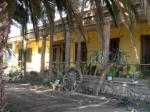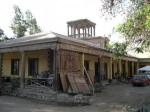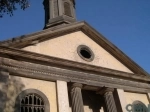House and Church of the Ex-Hacienda de Nantoco. Copiapo - CHILE
Direccion:
Tierra Amarilla, Región de Atacama Nantoco was Indian former in the prehispanic period (called Nantoco), directs and worship in the sixteenth and seventeenth centuries, and farm and mining town in the eighteenth and nineteenth centuries.
If Copiapo (then Copayapu) was the town where he was the principal seat indigenous population of the valley, Nantoco, 23 km, had nevertheless an important settlement and the Indians offered abundant harvest of pitch. With the flood of 1655 all those lands were devastated, flooding the town and the first Church.
From 1621 Nantoco lands belonging to Don Fernando de Aguirre Matienzo, whom the Captain General Don Cristóbal de la Cerda had awarded a grant of 1000 blocks. Don Francisco de Aguirre Riberos inherited this grant, which he then sold in 1687 to Antonio Mendoza Aguirre Child. In 1750, property of Don Felipe de Mercado building a chapel, which will form the basis for the vice Parish when it was established in 1764.
During the eighteenth century gold is exploited in the vicinity from 1783 and good copper lodes in the ravine of Nantoco same. In 1821, Dona Carmen Cerda Ossa Nantoco installed in a mill to benefit copper. Proceeds from the age of silver throughout this region of Atacama, Nantoco know a certain opulence and in 1860 Apolinario Soto, rich miner Three Points purchase the property. Soto, hired two carpenters who raise in his English country house estate with style and a unique church in proportion to the service of his estate and the area. In fact, the quality and scope of this church goes beyond the importance, even in the nineteenth century was the area.
Today, although in disrepair, the house and the church are a very interesting architectural rural. The Nantoco house is elevated on a high plinth style houses of the nitrate administration English. Distribute their bodies in a floor around a large courtyard closed to the south by a high adobe wall. The main body of two bays is elevated plinth and surrounded by a wide corridor supported by 10 fluted Doric columns. A funny air Greco-Roman viewpoint, very open and well proportioned is perched on the roof in the center of the lobby. The viewpoint of each side has four pillars with fluted Doric capitals connected by arches under the entablature and a balustrade at the height of the pedestal of the pillars. The classical elements in columns, moldings and entablatures as the symmetry of all its parts contribute to give this house a touch of style that sets it apart.
In front of the house is a park and beside the church, in clear English Georgian membership. The church was rectangular and had a single ship. Recent earthquakes gradually damaged much of the ship and remain standing only the portico and the tower on which it stands. The porch is a large triangular pediment spanning the entire width of the facade with pilasters that wrap around the corners and two Doric columns that frame. It has a window on each side of the door. The wooden bell tower is imposed on the porch. It is made by an octagonal base and two drums at the vertices decorated by pilasters on the first and the second small column, topped by a cupulón this.
Both structures are Guayaquil cane partition with mud plaster. All Douglas-fir wood is brought as ballast for ships from the United States. Today the house as the church requires a restoration.



